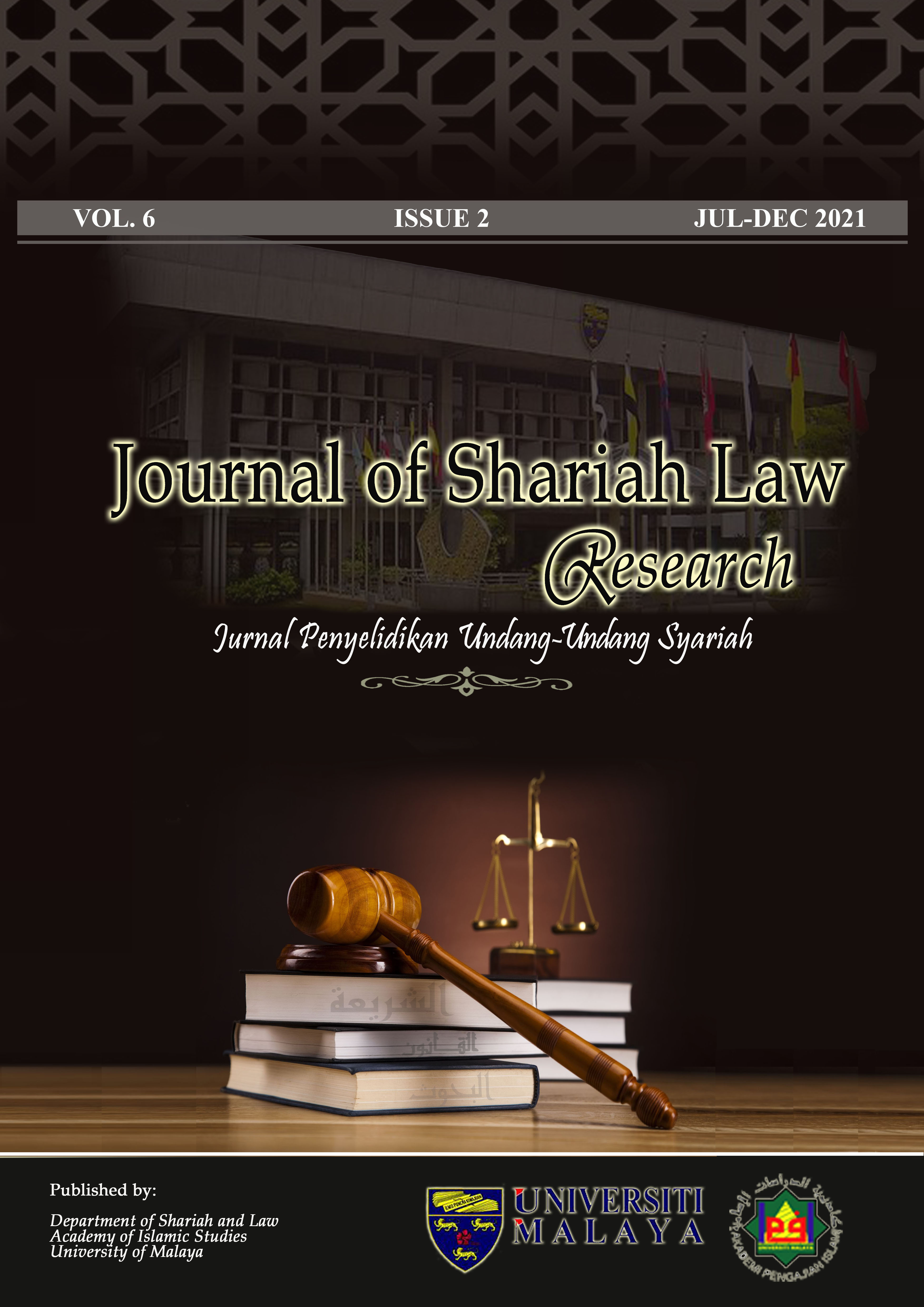KAEDAH HARMONISASI DALAM PENETAPAN NILAI GANTI RUGI BERASASKAN DIAT BAGI KES KEMALANGAN JALAN RAYA DI MALAYSIA
The Method of Harmonization in Determining Diyya-Based Compensation Value for Road Traffic Accident Cases in Malaysia
Keywords:
diyya, compensation, harmonization, damages, road traffic accidentAbstract
The practice of the conventional legal system implemented in Malaysia in terms of implementation and legal reference has not guaranteed the protection of victims as a whole. The quantum determination of damages sems to be complicated and not fixed as the proof depends heavily on the element of expectation and subject to the results of previous cases. This is in contrast to the Islamic method of damages which provides for a simpler and clearer method of awarding quantum of damages with a fixed rate for death and physical injury through the method of diyya and arsh in addition to space for the judge’s discretion for material and future damages based on ḥukūmah al-‘adl. This article assesses the space of harmony in determining the value of damages based on diat diat for road accident cases in Malaysia. The method used in collecting the data is upon observation, interviews and documentation. The data obtained were analyzed comparatively and content. The results found that the implementation of Islamic compensation through the diyya method emphasizes the element of rehabilitation between the victim and the liable. Diyya also highlighted that the rate of compensation is fixed but still has room for the judge’s discretion, as well as being able to balance justice between the victim and the party issuing the compensation.
Downloads
References
A. S. Diamond (2004). Primitive Law. Past and Present. London: Anthropology and Etnoghraphy Library.
Abdurrahman Raden Aji Haqqi (2015). “Criminal Punishment and Pursuit Justice in Islamic Law.” International Journal of Technical Research and Applications, Special Issue 15, 1-10.
Al-‘Aysawī, Najm ‘Abd Allāh Ibrāhīm (2002). al-Jināyah ‘ala al-Atraf fī al-Fiqh al-Islāmī. Dubai: Dār al-Buḥūth li al-Dirāsah al-Islāmiyyah wa Iḥyā’ al-Turāth.
Al-Bayhaqī, Ahmad Ibn al-Husayn. (2012). Sunan al-Bayhaqī al-Ṣughrā. Kartasyi: Jāmi‘ah al-Dirāsāt al-Islamiyyah, 188, no. hadis 4329.
Albert W. Dzur (2011). “Restorative Justice and Democracy: Fostering Public Accountability for Criminal Justice”, Contemporary Justice Review: Issues in Criminal, Social, and Restorative Justice. vol. 14, no. 4 368, 367-381.
Al-Shāfi‘ī, Muḥammad Ibn Idris (2001). al-Umm. Manṣūrah: Dār al-Wafā’ wa al-Ṭabā‘ah li al-Nashr wa al-Tawzī‘.
Al-Suyūṭī, Jalāl al-Dīn ‘Abd al-Raḥmān (2015). al-Ashbah wa al-Naẓā’ir fī Qawā‘id wa Furū‘ Fiqh al-Shāfi‘ī. Bayrūt: Dar al-Kutub al-‘Ilmiyyah.
Al-Zuḥaylī, Wahbah (1998). Naẓariyyah al-Ḍamān wa Aḥkām al-Mas’ūliyyah al-Madaniyyah wa al-Jinā’iyyah fī al-Fiqh al-Islāmī Dirāsah Muqāranah. Dimashq: Dār al-Fikr.
Bruce L. Berg (2004). Qualitative Research Methods for the Social Sciences. USA: Pearson Education.
Chua Yan Piaw (2016). Mastering Research Methods. Shah Alam: McGraw Hill Education.
CR Kothari (2004). Research Methodology: Methods & Techniques. New Delhi: New Age International Limited Publisher.
Gade, C.B.N. (2013). “Restorative Justice and the South African Truth and Reconciliation Process”, South African Journal of Philosophy, vol. 32, no. 1, 10-35.
Idris Awang (2001). Kaedah Penyelidikan: Suatu Sorotan. Kuala Lumpur: Akademi Pengajian Islam Universiti Malaya.
Johnstone Gerry, et al. (2007). Handbook of Restorative Justice. Devon, UK: Willan Publishing.
Mohammad Ali Heidari, et.al., “Study of Restorative Justice And Distributive Justice From The Perspective of Islamic Law And Jurisprudence”, New York Science Journal, vol. 8, no. 6 (2015), 80-85.
Muḥammad Aḥmad Saraj, Ḍamān al-‘Udwān fī al-Fiqh al-Islāmī Dirāsah Fiqhiyyah Muqāranah bi Aḥkām al-Mas’ūliyyah al-Taqṣīriyyah fī al-Qānūn (Qāhirah: Dār al-Thaqafah li al-Nashr wa al-Tawzī‘, 1990).
Muhammad Hilmi Musa (2015). “Penggunaan Emas dan Perak dalam Menentukan Nilai Pampasan Diyat: Suatu Analisis ke Atas Nilaian Pertukaran Matawang Semasa,” Jurnal Undang-undang dan Masyarakat. vol. 19, 17-28.
Mutaz M. Qafisheh (2012). “Restorative Justice in the Islamic Penal Law: A Contribution to the Global System”, International Journal of Criminal Justice Sciences, vol. 7, no. 1, 487-507.
Norman K. Denzin (2011). The SAGE Handbook of Qualitative Research. United Kingdom: SAGE Publications Ltd.
P. S. Barnwell (2000). “Emperors, Jurists and Kings: Law and Custom in the Late Roman and Early Medieval West,” Oxford Journals: The Past & Present Society, no. 168, 6-29.
Paizah Ismail (2012). “Pelaksanaan Diyat dalam Kerangka Cabaran Fiqh Semasa”, Jurnal Fiqh, vol. 9, no. 9.
Ramizah Wan Muhammad (2012). “Restorative Justice in Islamic Criminal Legal System”, Journal of Islamic Law Review, vol. 12, no. 2, 191-213.
S. Santhana Dass (2001). Personal Injury Claims. Petaling Jaya: Alpha Sigma Sdn Bhd.
Sabitha Marican (2005). Kaedah Penyelidikan Sains Sosial. Petaling Jaya: Pearson Malaysia Sdn. Bhd.
Salleh Buang (1999). Undang-undang Kecuaian di Malaysia, terj. Asiah Mohd Yusof. Kuala Lumpur: Dewan Bahasa dan Pustaka.
Shazia Qureshi (2015). “Research Methodology in Law and Its Application to Women’s Human Rights Law.” Journal of Political Studies, vol. 22, no. 2, 629-643.
Siti Zubaidah Ismail (1999). “Kemalangan Maut Jalan Raya Menurut Perspektif Undang-undang Malaysia dan Islam,” Jurnal Syariah, vol. 7, 91-106.
Siti Zubaidah Ismail (2012). “The Modern Interpretation of the Diyat Formula for the Quantum of Damages: the Case of Homicide and Personal Injuries,” Arab Law Quarterly, vol. 26, 361-379.
Susan C. Hascall 92011). “Restorative Justice in Islam: Should Qisas Be Considered a Form of Restorative Justice,” Berkeley Journal Middle East. & Islamic Law, vol. 4, 35-78.
T. F. Marshall (1999). Restorative Justice: An Overview. London: Home Office Research Development and Statistics Directorate.
Tuckman, Bruce W., (2012). Conducting Educational Research. Lanham: Rowman & Littlefield Publishers.
Van Ness et al. (2010). Restoring Justice: An Introduction to Restorative Justice. New Province: Matthew Bender & Co., edisi 4.
Wan Roslili Abd. Majid & Najibah Mohd Zain (2015). “Isu dalam Penahanan dan Pemulihan Banduan di Malaysia,” Kanun: Jurnal Undang-Undang Malaysia, vol. 27, no. 1, 143-168.
Wing Hoi Chui (2007). Research Methods for Law. Edinburgh: Edinburgh University Press.





